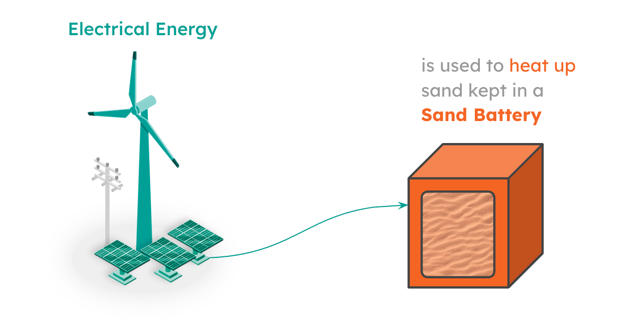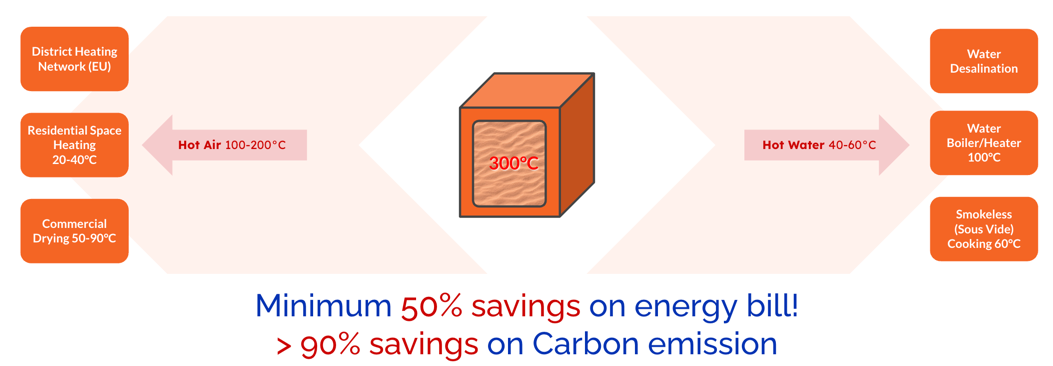What is Sand Battery? (SAND - Part 1)
What is Sand Battery? How does it work? It all began in November 2022...

The Sand Battery stores Thermal Energy, not electricity, and is also known as Thermal Energy Storage Solution.
A Sand Battery is a container of regular sand at high temperature 300°C (572°F) and above. What you see in the photo above, the shiny cylindrical container, is my DIY Sand Battery! Yes, home-made version, and it worked!
Thermal Energy what?
There are many types of energy, the most common one being Electrical Energy, which everyone understands. But there are also Thermal Energy, Mechanical Energy, Nuclear Energy, Gravitational Energy...
Thermal Energy consumption makes up roughly 50% of our energy bill, we all use electricity to keep warm, or keep cool; same for industrial and commercial buildings. So in fact when we need the cool or the warmth, we actually convert electrical energy to Thermal Energy by turning on a heater or air-con at home. That means direct use of electricity converted to thermal energy at the point of consumption.
Storing Thermal Energy in a sand-box
Now, instead of direct consumption, what if we can store the heat (at relatively high temperature) in an insulated box of something and use it for later, assuming that the energy inside doesn't go anywhere.
In theory, we can convert the electricity from Solar panels, into thermal energy by heating up the sand via typical resistive heating rods. With a good insulation all around, the heat should stay within the box, and then we can use the heat energy in there for heating purposes. The conversion of energy from Electricity => Thermal Energy is rated at 98% efficiency (minor losses in wirings), this will be important later.
This was my naive believe before I embark on the journey to build it. The illustration below simplified the concept.

Who invented the first Sand Battery?
Not me, I would never claim I made the first one, here's the origin.
The first known commercial application of thermal storage was invented way back in the 70s, one prominent source of literature was from NASA, they have actually produced several work on the topic, one of such is NASA Conference Publication 2 125 (December 1979). Some are so old that the patents has expired.
But really what caught my attention first was Polar Night Energy Thermal Battery with 100-ton of Sand, announced in the mid-2022, picture below. This particular one is built in Finland, and hooked directly to existing District Heating Network, which supplies hot water to homes typically in EU countries.


What kind of .... Sand?
Any kind of sand should be suitable for Sand Battery, that is for storing thermal energy purposes.
However, in real-world, we are targeting sand from desert because of the following factors:
- It's cheap, available locally every country.
- No one really uses it, not for construction.
- Free of toxic materials and impurity.
- Small, round particle of desert sand has the best density.
What is Sand Battery good for?

It can be used for many many applications, at the very basic, anything that requires heat, long duration of heat, can be adapt to leverage clean heat from a Sand Battery source.
It can save ~ 50% of your energy bill, in most cases, and the best thing is since it does not involve burning of any materials, no phase changes of any kind, there is almost Zero emission in the process.
These numbers are insane yes, and they are also science-proven.
Over the past 3 years, my team has done so much work on this and we have achieved several breakthrough in energy efficiency, backed by real-world data from our commercial pilots (more details in later episodes).
How does it work ... again?
Let's go through the stages how a Thermal Battery works.
1. Charging Stage

We can use nearly any electrical energy sources to charge the sand battery, aka, heating up the sand inside the container, by the way of resistive heating rods. The heating rods is made of special materials that can withstand up to 2000°C, and in the commercial version, this rod can run for years on end. These elements are the only consumable part of the entire system, also it is relatively cheap to replace.
2. Storing Energy Stage
The container is made up of highly insulated materials (think of fiber glass, ceramic wool, vacum seal panel,...) this layer is thick and covering the entire outside of the core sand block.

It sounds simple but in reality, having 600°C on one side, and normal room temperature outside the box is pretty challenging. This aspect of the thermal energy storage solution, the science of material, is the most crucial factor of the whole solution, in my perspective. The ability to store the heat at high temperate, with minimal daily losses determines the capacity of the battery, the higher the temperature, the larger the thermal capacity.
3. Discharging Stage
When we need to discharge the heat energy, we can turn on the fan, which pushes normal air, through a series of metal tubes inside the core sand block. This long network of tubes strategically positioned inside the sand, allows the air going through it to heat up by absorbing the heat from sand.

The end result is a constant stream of hot air at 200-300°C.
Alternatively, in theory, we can run water through the pipes and get hot/warm water at the end of pipes. This is easy to say in theory, but in practice, the design for the piping would be quite different for water versus air. We did make a lot of mistakes, learnt a lot through out the 3 year research, to the point that we concluded we needed to design two different systems for water/air.
How long does a Sand Battery last?
It is a really complicated and loaded question, but to dump it down, we can measure in weeks and months, not just minutes or hours.
How is this so? Sand or Silica is a material that can hold heat for a very very long time. In Finland, the country experience 6 months of sun and 6 months of winter; The original sand battery by Polar Night Energy holds the heat for six months of winter and it takes six months to charge during the summer.
Our first full-scale prototype which contains about 800kg of Sand, could technically hold the energy for about 3 weeks before it cool down to room temperature, starting from full capacity at ~600°C.
If you are still curious, it depends on the temperature of the sand, the environment, the quality of insulation layers, the volume of sand, the monitoring & control equipments, etc...
My Home-made Sand Battery
So I embarked on my side project, initial purpose was testing heat-retaining materials for off-grid living. Initially my objectives was just the ability to have nice hot shower in an off-grid cabin somewhere without grid electricity, in a cool climate of 15-25°C (59-77°F).
It started from my apartment balcony. November 2022.

1. Generating the heat: The first setup was just this setup, I simply put together a bucket of sand, stuck a heating rod inside those using AC power. You can see that it reached 165°C (329°F) at the hottest spot. I was surprised to see the power consumption, it was barely 1kwh for the whole experiment, so super cheap to heat up sand.
2. Storing the heat: Using the stainless steel double-layer food container, it does a reasonable job at isolating the heat. At 165°C, I can still touch the outside of the container wall without using gloves, the outside wall of the container is is relative warm at 40°C.
That's me & my son, assembling a home-made Sand Battery, with 20kg of white fine sand.
3. Using the heat, getting warm water: In the setup I also run a copper tube inside the hot sand, I just happened to have an extra tube from an old air-con, and I bent it with my own hands, submerge in sand and connect the PVC tubes on the 2 ends. By circulating normal water through the core block of the sand battery, using regular aquarium water pump, I actually got warm water in the kettle at ~60°C. But of course, this does not last for long, the temperature will drop gradually once it reaches peak. Total experiment lasted about two hours, before everything went back to normal temperature.
Sand Battery Prototype Zero
Completed in early December 2022, this is the Prototype #0 that never made the news, you see it first here.
Painting the Sand Battery Prototype #0

To be continued in Part 2 – How does Sand Battery save energy




